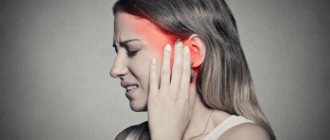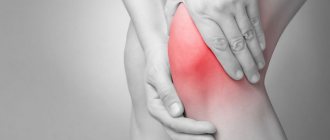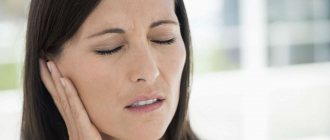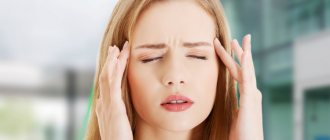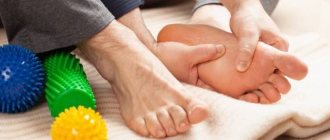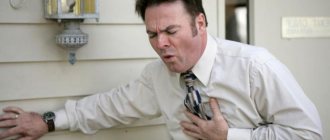If you constantly shoot in the temple, this is a reason to take a closer look at the pathological symptoms and think about the state of your health. A headache can be a consequence of a dangerous illness that needs to be treated promptly, or a sign of exhaustion or chronic fatigue. To find out the cause of the syndrome, you need to see a doctor and undergo an examination, and not try to eliminate it yourself.
Signs that pain in the cervical region is radiating to the head
This symptom is usually characterized by initial pain in the neck, after which it “shifts” to the head. Neck pain is most often caused by various pathological processes occurring in this area:
- inflammatory;
- degenerative-dystrophic;
- traumatic origin.
Headaches that occur due to problems in the cervical spine are called cervical. It is different from “classic” migraine. Cervical pain is usually defined as dull pain, often localized in the back of the head, but sometimes spreading to the temples and eyes. Even less commonly, it appears in the upper part of the head (forehead and crown), as well as in the ear area. This pain is often accompanied by:
- stiffness and pain in the neck (when trying to turn the head);
- tingling or numbness in the shoulder girdle and arms;
- dizziness (with nausea);
- ringing in the ear;
- inability to concentrate;
- muscle weakness;
- depression.
According to the nature of its manifestation and connection with the provoking pathological mechanism, cervical pain can be:
- arteriospastic (aching pain is observed in all parts of the head);
- arteriodilatatory (pain of a pulsating nature is localized in the temples and back of the head);
- venous (pressing pain in the morning);
- muscular-tonic (aching in nature, encircling the parietal region with a “hoop”);
- liquor-hypertensive (bursting in nature with pressure on the eyes);
- neuralgic (with attacks of “shooting” pain).
Diagnosis and when to get tested
Since there are many causes of spasms, only a qualified neurologist can make a correct diagnosis. Some diseases are dangerous and can lead to death. That's why you need to find out in a timely manner why it shoots in the temporal region. Correct diagnosis is the key to adequate therapy.
Comprehensive diagnostics of pathology includes the following examination methods:
- Laboratory tests.
- Ultrasonography.
- Study of the fundus.
- Examination of hormonal levels.
- CT and MRI.
- Resonance magnetic angiography.
- Cardiac monitoring.
- Consultations with specialized specialists: neurosurgeon, endocrinologist, cardiologist, otolaryngologist, ophthalmologist.
If pain in the left hemisphere is regular, its origin should be established as quickly as possible. A general practitioner or neurologist will help determine the cause of spasms in the temporal region.
Fundus diagnostics is one of the methods for diagnosing pathology
If you have the following symptoms, it is recommended to urgently undergo examination by a qualified doctor:
- uncharacteristic spasms, intense, localized in unusual places or the appearance of additional symptoms: fever, vomiting;
- cephalalgia resembling an “explosion”;
- headaches accompanied by visual impairment: blurred vision, spots, darkness, slurred speech, numbness in the mouth, weakness of the limbs;
- “inaction” of analgesics after their use;
- low-grade fever;
- frequent vomiting;
- sudden increase in spasms during exercise;
- tension, soreness of the muscles of the back of the head.
Such symptoms may indicate the presence of dangerous pathologies such as stroke, meningitis or encephalitis. In this situation, you need to urgently seek medical help and call an ambulance team.
Who more often experiences pain in the cervical spine radiating to the head?
This symptom does not depend on race, gender, or age. Moreover, it is usually more often observed in people aged 20 to 60 years and older (since it is directly related to the development of cervical osteochondrosis, which affects almost 90% of people after 65 years). According to statistics, cervical pain is most often recorded in those who:
- has a sedentary job in an office at a computer;
- works professionally as a driver;
- associated with regular strength loads (professionally or in sports);
- has chronic problems with normal cerebral circulation;
- suffered injuries to the cervical spine;
- has a genetic predisposition.
First aid for pathological conditions
Shooting pain in the right temple is a dangerous sign; when it appears, it is better to immediately consult a doctor to determine the cause of the syndrome. If you endure unpleasant discomfort for a long time, serious visual and hearing problems may develop. The patient's psychological state may deteriorate.
With intense spasms in the temple on the left, a stroke of the “gray matter” is possible. If strong lumbagoes appear in the head, you should monitor their frequency and duration. If the pain is one-time in nature and is not accompanied by additional symptoms, the following measures can be taken:
- When your temple is pulsating, it is better to take a walk in the street, a park, or ventilate the room well.
- Wash with cool water and take a shower.
- Perform a temple massage.
- Reduce lighting intensity and eliminate extraneous sounds.
- Relax, get a good night's sleep.
- Take a pain reliever.
If the patient is sure that spasms in the left temple are the result of a hangover or a cold, then you can take a medication that reduces the intensity of unpleasant symptoms of ARVI or flu. Sometimes it is recommended to use traditional medicine recipes that help eliminate vascular swelling and nourish the “gray matter” with vitamins and microelements.
When your temple throbs immediately after eating, you need to carefully study the composition of the food. If a food that causes unpleasant discomfort has been discovered, it is recommended to exclude it from the diet. If you need to buy ready-made food, it is better to give preference to baked goods, salads and pies.
With intense spasms in the left temple, a stroke of the “gray matter” is possible
What diseases cause pain in the cervical region to radiate to the head?
The most common causes of this symptom are the following diseases or pathological conditions:
- cervical osteochondrosis – observed in almost 90% of elderly people, which is associated with age-related deformation of the bones and cartilage that make up the cervical spine, with severe pain localized at the base of the skull, in the temples, often accompanied by decreased vision (against the background of eye “fatigue”), can also develop due to a passive lifestyle, excess weight or genetic predisposition;
- spinal injuries – including microtraumas received from impacts, falls during sudden braking or acceleration while the vehicle is moving;
- circulatory disorders - due to hypertension, or insufficient blood flow to the brain due to atherosclerosis of the vertebral artery;
- cervico-occipital neuralgia - pain spreads along the head, covering the temples, eyes and forehead (in the direction of the affected nerve);
- stress and physical or mental exhaustion - neck pain radiating to the head, in this case, serves as a prerequisite for the development of osteochondrosis.
Origin of the pathological condition
Headaches are the first symptom of many disorders in the body’s performance. Most often it shoots and hits the temple for the following reasons:
- Overwork. Patients exposed to stress, depression and leading an unhealthy lifestyle often suffer from headaches. The pathological condition usually lasts for several hours, after which it improves.
- Migraine. Unpleasant discomfort in the left temporal region often appears in pregnant women and adolescents. The syndrome is accompanied by visual impairment, vomiting, nausea, and arrhythmia.
- PMS. At this time, changes occur in the female body in the endocrine system, one of which is painful pulsation.
- Hormone synthesis disorders. This process is manifested by intense spasms in the forehead, temples, and back of the head. Often such attacks are diagnosed in patients during menopause, accompanied by sudden mood swings and hot flashes.
- Infectious pathologies and inflammation. With a cold, flu, or acute respiratory viral infection, there is often a strong pulsation in the head, which disappears after recovery.
- Intoxication. In case of poisoning, in addition to vomiting, nausea, painful sensations may appear, severe pain in the left temple. Similar symptoms are observed with hangover syndrome.
- Vascular atherosclerosis. The disease is accompanied by an unpleasant pulsation in the temple on the left side, and can increase and then subside. The syndrome occurs against a background of impaired vision, hearing, coordination and memory.
- Low or high blood pressure. Weakness, rapid heartbeat, and pain on the left or right side of the temple may appear. Sometimes patients lose consciousness.
- Pathologies of the adrenal glands. It is characterized by excessive production of adrenaline, resulting in vascular spasms and increased blood pressure.
Most patients make a mistake when they do not pay attention to the unpleasant discomfort, do not rush to see a doctor, and try to eliminate the syndrome using traditional medicine. But spasms in the left temple can be a symptom of a dangerous pathological condition that can lead to irreversible consequences.
People prone to stress, depression and overwork often suffer from headaches.
Other causes of painful spasms in the temple include:
- VSD (nervous system disease);
- cervical osteochondrosis;
- injuries and pathologies of facial joints, cranial nerve endings;
- chronic inflammatory process of the temporal vessels;
- hunger cramps during strict diets;
- inflammatory, infectious diseases of the oral cavity;
- food pulsating pain due to the abuse of certain foods;
- inflammation of the membranes of the “gray matter”.
All these conditions require immediate consultation with a doctor; you should not delay treatment, but undergo a comprehensive examination. In the early stages of the disease, painful symptoms can be eliminated and further development of the pathology can be prevented.
Inflammatory process of the temporal vessels
Which doctor should I see?
If pain in the cervical spine radiates to the head , it is better to immediately contact a neurologist (or orthopedist-traumatologist) to accurately diagnose the current condition and identify the causes of pain in the neck and head. This is especially true for pain that does not stop for several days or often recurs.
Are you worried about neck pain that radiates to your head? Don't waste your time. Qualified medical specialists are always ready to determine the exact cause of your illness and return you to the true joy of life without pain as quickly as possible!
Shooting pain in face
Trigeminal neuralgia (facial Fothergilla pain, painful tic, neuralgic prosopalgia)
Among neurogenic pain syndromes caused by damage to the cranial nerves, the main place is occupied by trigeminal neuralgia (TN). NTN is one of the most common neurological diseases of the face, second in frequency only to facial neuropathy. The disease occurs in 3-7% of other types of headaches. Women (5:3) over 40 years of age are more often affected. It is characterized by a severe course and the absence of sufficiently effective treatment methods.
Pain with NTN is paroxysmal in nature, stereotypical, lasting from several seconds to 2 minutes, characterized by significant intensity, suddenness, reminiscent of an electric shock or lumbago. Pain can be provoked when eating, talking, as well as mechanical irritation when washing, brushing teeth, etc. Negative emotions can provoke a painful attack during an exacerbation. The highest frequency of exacerbations is observed in the autumn, less often in winter, periods of the year, which demonstrates the role of meteorological factors. Spontaneous pain may occur.
NTN is characterized by paroxysmal pain. Interictal pain of varying intensity of a dull or burning nature, paresthesia against the background of hypoesthesia, arising after injection-destructive treatment, are explained by associated neuropathy. Neuropathy of the branches of the trigeminal nerve can also be of odontogenic origin; it is a consequence of an inflammatory process or trauma during tooth extraction and is discussed in the section on symptomatic pain associated with dental damage.
The onset of NTN can occur in different ways: in some cases, typical paroxysms immediately appear, in others, local paroxysmal or constant pain first appears in the area of one or several teeth, which over the course of several months or years turns into typical neuralgia. The disease progresses with exacerbations and remissions. During the period of exacerbation of the disease, patients answer questions in monosyllables, barely opening their mouths, since the slightest movement of the facial muscles can cause a painful paroxysm. During an attack, patients freeze. Some try to squeeze the sore side with their hand or rub it roughly. During attacks, pain can be grouped in volleys; the interval between individual attacks is short, between volleys longer. Status neuralgicus is described when there are no gaps between individual volleys. As a rule, volleys can last for hours, and periods of attacks can last for days and weeks.
One of the reasons may be pathology of the dental system; Often the disease develops after tooth extraction. In most cases, the lower alveolar nerve is affected when the lower molar is removed, which is the terminal branch of the mental nerve. First, numbness and constant pain appear, which over time transform into typical neuralgic attacks. This form of neuralgia is called odontogenic.
In some cases, NTN may occur as a result of circulatory problems in the brain stem. In this case, the formation of the syndrome occurs at the level of the nucleus of the descending tract.
Postherpetic neuralgia is a complication of herpetic Gasserian ganglionitis and occurs in 10% of patients.
The most common form is the “idiopathic” form, the mechanisms of which have been studied quite well recently. The term “idiopathic” is used only conditionally in the 1988 international classification of headaches, which discusses the tunnel-compression mechanism of this most common form of neuralgia.
Treatment.
Prescribing analgesics for trigeminal neuralgia is practically ineffective. The fish drug is carbamazepine (finlepsin, tegretol) 600-800 mg per day. Other anti-epileptic drugs are used. With long-term use of antiepileptic drugs, their effectiveness is significantly reduced. Under these conditions, it is recommended to periodically change the drug or add gamma-aminobutyric acid derivatives to them - phenibut 0.25-0.65 g or pantogam 0.5-1 g 3 times a day.
Of no small importance is the treatment of patients with antidepressants, which soften the perception of pain, reduce fear of an attack, eliminate depression, and change the functional state of the brain.
In patients with vascular diseases of the brain (dyscirculatory encephalopathy), the treatment regimen includes vasoactive drugs: Trental, Cavinton, etc.
For the treatment of trigeminal neuralgia, glycine myeglinol (amino acid glycine) at a dose of 110 mg/kg body weight before meals has been proposed. The drug is dissolved in 50 ml of water. The course of treatment is 4-5 weeks. Myeglinol has a central effect on hyperexcitable neurons and a peripheral effect: it reduces the content of formaldehyde and thereby promotes remyelination.
In case of complete ineffectiveness of conservative therapy, there is a need to use surgical treatment methods: resection of the branches of the trigeminal nerve, decompression of neurovascular bundles, stereotactic operations to decompress the trigeminal nerve root. The most commonly used are thermoisotomy and microvascular decompression. The first is less traumatic, since it is performed without craniotomy, repeated operations are possible, has a minimum of complications and can be performed in older people. However, thermorizotomy produces more side effects: impaired chewing, painful dysesthesia in the facial area. Microvascular decompression consists of trephination of the posterior cranial fossa, revision of the relationships between the trigeminal nerve root, the superior anterior cerebellar artery, and, less commonly, the inferior anterior cerebellar artery and the superior petrosal vein. When the root is compressed by vessels, they are isolated, and a gasket is placed between the vessels and the root to prevent contact between them and the impact of the vessel on the root.
Despite the encouraging results of rhizotomy and microvascular decompression, especially in the early postoperative period (64 and 90%, respectively), the problem of pain recurrence remains.
In this regard, it is relevant to develop new methods of surgical treatment, the simultaneous use of surgical techniques at various levels of the trigeminal nerve system, depending on the predominance of distal or proximal tunnel-compression factors, as well as combination with pharmacological methods. To prescribe individual treatment and professional consultation, you can make an appointment with the specialists of the Pain Clinic. To do this, just call the phone number or fill out the feedback form, and you can also make an online appointment with doctors on our website. Health and prosperity to you and your loved ones!
Features of complex therapy of the syndrome
Depending on the type of pathology that provoked the appearance of spasms in the left hemisphere of the head, the doctor prescribes appropriate treatment. Treatment of the pathological condition may include the following medications:
- sorbents;
- if your temple is throbbing, medications that eliminate swelling of blood vessels will help;
- anti-inflammatory drugs;
- if your temple hurts, antipyretic tablets are prescribed;
- sedatives that have a sedative effect;
- antibacterial drugs.
Complex treatment may include warming creams if spasms occur due to prolonged exposure to cold or drafts. Physiotherapy is also often prescribed, including:
- Therapeutic baths.
- Wraps using special mud.
- If your temple hurts, a course of massages is indicated.
- Electric phoresis.
- Magnetotherapy.
- Treatment through acupuncture.
When headaches in the left temple are the result of overwork, a strict diet or excess food, a person should change their diet and lifestyle to eliminate the pathological factors causing the malaise.
Physiotherapy will include medicinal baths
Headache in the temples and eyes: treatment
The first thing you need to do for subsequent effective treatment of headaches in the eyes and temples is to go to the doctor. You should not treat this phenomenon as a symptom; in fact, you need to identify the cause of the pain and destroy it.
Acute headache in the temples, which does not affect your general health, can be cured at home. Treatment methods are as follows: rest, sleep, shower, herbal tea, walks in the fresh air. If these methods are ineffective, you can take a paracetamol tablet. An alternative to paracetamol can be painkillers and anti-inflammatory medications, for example, analgin, ibuprofen, aspirin and others.
Clinical Brain Institute Rating: 4/5 — 17 votes
Share article on social networks
In what cases should you not postpone a visit to the doctor?
The patient requires urgent medical attention if headaches are accompanied by the following symptoms:
- vomiting and nausea;
- visual impairment;
- loss of consciousness;
- difficulties in pronouncing words and recognizing someone else's speech;
- increased body temperature;
- numbness or weakness on one side of the body;
- tension in the neck muscles.
Symptoms such as these may be signs of serious illnesses such as meningitis, encephalitis, or stroke. In this case, you cannot delay contacting a doctor, and you should immediately call an ambulance.


